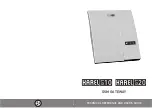
Troubleshooting
2. Installation
This section will help you:
physically install your HH1620, and
establish a first connection between a PC and the HH1620.
Once this first connection is made, you can configure the HH1620 to support all of the other
wired and/or wireless connections you need.
Physical Installation of the HH1620
Positioning Your HH1620 for Optimal Wireless Performance
The HH1620 uses a radio transmission technology defined by the Institute of Electrical and
Electronics Engineers (IEEE) called 802.11 Wireless Fidelity (Wi-Fi). This standard is
subdivided into distinct categories of speed and the frequency spectrum used, designated by
the lower case letter after the standard.
For example, your router supports both the ‘b’ and ‘g’ specifications. The 802.11b
specification transmits data rates up to 11 Mbps while the 802.11g specification transmits
data rates up to 54 Mbps. These are theoretical standards so your performance may vary.
The radio waves radiate out in a donut-shaped pattern. The waves travel through walls and
floors, but transmission power and distance are affected. The theoretical distance limit is
1,000 feet (305 meters), but actual throughput and distance varies.
Both standards operate in the 2.4 GHz range, meaning other electrical appliances also might
interfere with the router – televisions, radios, microwave ovens, or 2.4 GHz cordless
telephones. Therefore, positioning your router where it encounters the least interference helps
maintain a better connection.
The following lists the expected wireless range of the router. This table is only a guide and
coverage varies due to local conditions.
Data Rate
Open Area
Closed Area
54 Mbps
Up to 100 ft (30m)
Up to 60 ft (18m)
11 Mbps
Up to 900 feet (275 m)
Up to 160 feet (49 m)
5.5 Mbps
Up to 1300 feet (396 m)
Up to 200 feet (61 m)
2 or 1 Mbps
Up to 1500 feet (457 m)
Up to 300 feet (91 m)
To achieve the best wireless performance, review these guidelines before deciding where to
place your router:
Placing your base station in the physical center of your network is the best location
because the antenna sends out the signal in all directions.
Placing the router in a higher location, such as on top of a cabinet, helps disperse the
signal cleanly, especially to receiving locations on upper stories.
If possible, position your router so there is direct line of sight between the router and
your other home network devices.
Avoid placing the router next to large solid objects like computer cases, monitors, walls,
fireplaces, etc. This helps the signal penetrate more cleanly.
Other wireless devices like televisions, radios, microwaves, and 2.4 GHz cordless
telephones can interfere with the signal. Keep these devices away from the router.
Mirrors, especially silver-coated, can reduce transmission performance.
HH1620 Wireless VoIP Gateway
User’s Guide
14
Содержание HH1620
Страница 1: ...User Guide HH1620 Wireless VoIP Gateway ...
Страница 35: ...Configuration Statistics WAN Statistics ATM HH1620 Wireless VoIP Gateway User s Guide 28 ...
Страница 36: ...Configuration Statistics ADSL Statistics VDSL HH1620 Wireless VoIP Gateway User s Guide 29 ...
Страница 42: ...Configuration HH1620 Wireless VoIP Gateway User s Guide 35 ...
Страница 53: ...Configuration Certificate Local HH1620 Wireless VoIP Gateway User s Guide 46 ...
Страница 54: ...Configuration Certificate Trust CA HH1620 Wireless VoIP Gateway User s Guide 47 ...
Страница 78: ...Troubleshooting 3 Release the reset button 4 The HH1620 restarts HH1620 Wireless VoIP Gateway User s Guide 71 ...
Страница 88: ...Visit our website at http www motorola com ...
















































